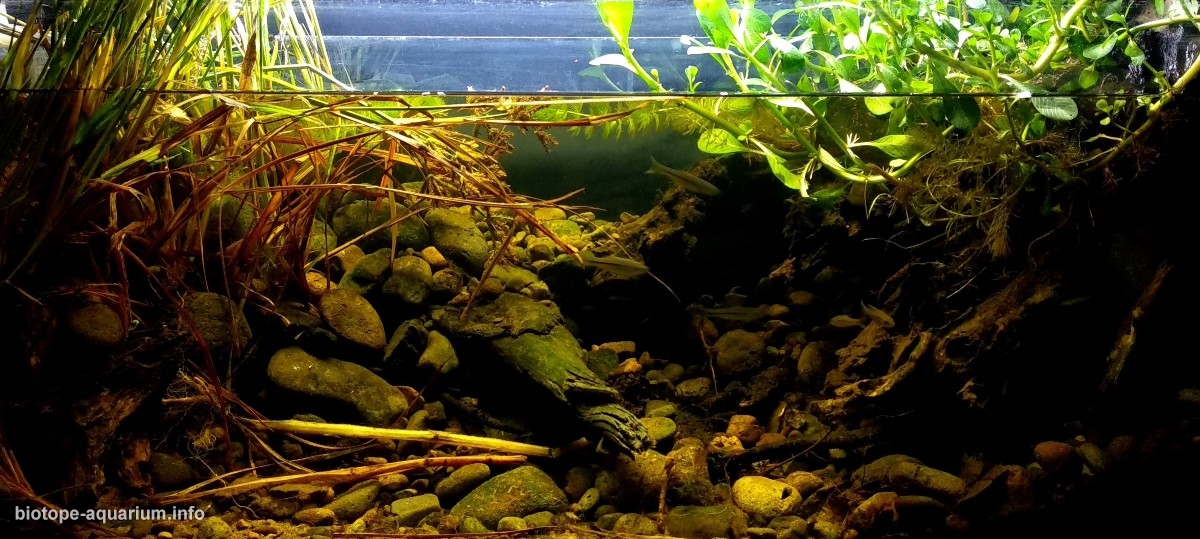Outskirts of the river Progo in the dry season, Central Java, Indonesia
68th place in Biotope Aquarium Design Contest 2019
Indonesia. Ahmad Nasrul

Volume: 160 L
Dimensions: 100×40×40 cm
List of fishes: barbodes binotatus, nemachilus faaciatus, crustacea, rasbora argyrotaenia, poecilia reticulata, sulcospira testudinaria
List of plants: imperata cylindrica, cyperus rotundus, ceratophillum demersum, ludwigia adscenden
Description of decorations: the elements that I use such as wood, stone, sand in the biotope aquarium use material available on the outskirts of the progo river that I assembled into a work of the river’s artificial ecosystem
Description of equipment: aquarium uses an amara DIY canister filter filter system 1200L / h with biological filter media.
use the 6000 led strip lighting 6500K
Water parameters: aquarium parameters with PH 7, temperature 25 ° c, DHL 230 and TDS 215
Additional info: water aquarium is replaced by 40% every 2 weeks to keep the ecosystem awake and reduce ammonia from fish feces .
INFORMATION ABOUT BIOTOPE
Description of the area surrounding the biotope: The Progo river is sourced from the slopes of Mount Sundoro-Gunung Sumbing which cross to the southeast then south along 140 Km. in the Ngluwar District area, magelang regency. with coordinates -7,6658990, 110,2665075, Kali Progo dammed into two streams for irrigation facilities for the people of Yogyakarta by the Dutch. This dam is known as “Ancol Bligo” which is now a place for recreational residents. this one irrigation stream flows from Ngluwar to the east, divides Sleman Regency and goes to Klaten Regency and is known as the Mataram Gutter (or “Van Der Wijck Gutter”), while the other one flows in Kulonprogo Regency to survey the Menoreh Mountains valley. Kali Progo empties to the west of Kwaru Beach, on the south coast of Java.
In the area around the estuary, sand mining is often found. Upstream, in the Magelang area, the river flow is utilized by fans of White Water Rafting to try out their abilities. in the lower Progo stream there are Kisik River Camp rafting operators and kayaks. there are also many young people who fish for their holidays. This river has thrilling rapids and stunning views along the river .
Description of the underwater landscape of the biotope: This river flows in the southern region of the tropical island of Java (code: Am according to the Köppen-Geiger climate classification). water depth in the dry season from 40 – 300cm in its deepest part. The average annual temperature is around 24 ° C. the hottest month is January, with an average temperature of 27 ° C, and the coldest July, around 23 ° C. The average annual rainfall is 2970 mm. The month with the highest rainfall is January, with an average of 537 mm, and the lowest in September, averaging 22 mm .
Description of the parameters of the habitat: the water parameters in this river are stable with ph 7. the average temperature is 24 ° c. the flow is always heavy and increasingly heavy when the rainy season arrives
List of fishes and invertebrates occurring in the nature biotope: There are 3 species
which are introduced fish, namely:
Poecilia reticulata introduced from Venezuela, Xiphophorus helleri from Mexico and Oreochromis Mossambicus from Africa. Three species of fish introduced into
Indonesia for different reasons. Species
Poecilia reticulata and Xiphophorus helleri as ornamental fish aquarium, it’s likely not accidentally released to river. Species
Oreochromis Mossambicus enter
to Indonesia as an alternative food consumption,
so deliberately kept in the pond, released into rivers, lakes or reservoirs to breed and get
fishing.
Barbodes binotatus, Mystacoleucus obtusirostris and Channa gachua is a local fish consumed and often lured by the surrounding community. Fish Barbodes binotatus, Poecilia reticulata and Xiphophorus helleri more common in shallow, calm and clear water, especially on the banks of rivers.
Barbodes binotatus and Xiphoporus helleri
likes to swim in the middle of the water depth, whereas
Poecilia reticulata prefer to swim on the surface and more
mend the banks of the river. Fish
dermogenys pusilla more often found on the surface of the water that flows rather heavy, and these fish have a habit to swim against the water flow. Fish Mystacoleucus obtusirostris and Lepidocephalichthys hassel more common in deep and calm water, on a base
sandy river or land. How to escape this fish by pushing its tail on the sand of the river bed so that the water becomes cloudy and the fish can swim away safely.
Channa gachua found a lot
hiding between rocks / overdrafts at the bottom of the water,
both fast-flowing but shallow and deep
and calm with rocky riverbed.
Channa gachua more often appear berakvitasitas on evening.
there are also rasbora argyrotaenia, namachilus fasciatus, crustaceans, and many others
List of plants found in the nature biotope: some of the plants found on the banks of the Progo River include ludwigia adscenden, cyperus rotundus, ipomoea aquatica forsk, murdannia, marsilea, eichhornia crassipes, ceratophillum demersum, imperata cylindrica and many others found along the progo river flow
Threats to the ecology: The aquarium that I made was intended to make people aware of the importance of preserving natural beauty, especially the underwater river Progo habitat, and behaving well. now the quality of water has begun to decline due to excessive use of agricultural chemical drugs, factory waste disposal, and wastehousehold to the river. Excess chemical residues can cause damage to ecosystems and poisoned dead fish
Sources of information:
I got this information from personal review and from the following sources
https://id.m.wikipedia.org/
https://www.neliti.com/id/
https://m.republika.co.id/
http://puslit2.petra.ac.id/
